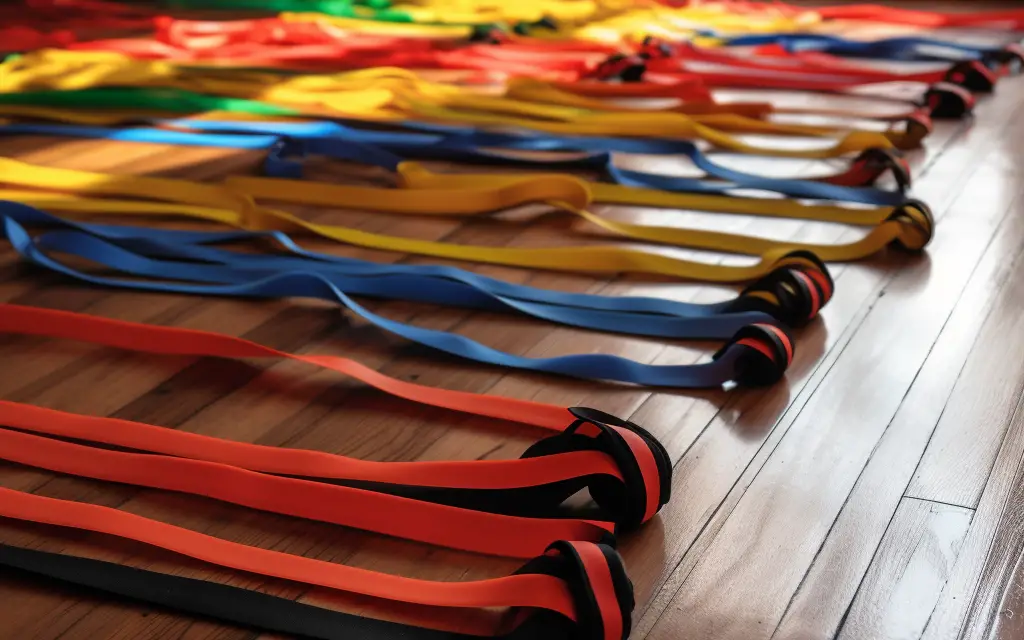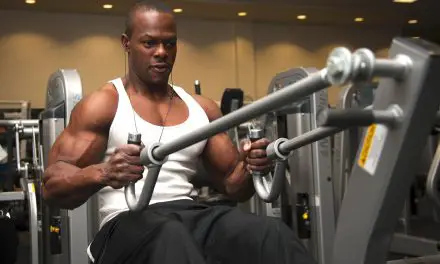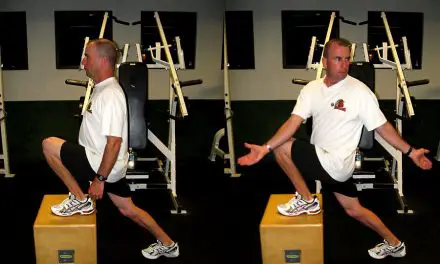Resistance bands are often used in fitness and rehab settings to improve strength, motor control, flexibility, and body awareness. They are made of a strong type of latex, rubber, or fabric that can be stretched and pulled in various directions.
While rubber and latex are commonly used because they’re lightweight, durable, and provide a consistent resistance, fabric resistance bands might be a better choice for some people who are allergic to latex.
Resistance bands come in various strengths, lengths, and thickness that allow you to adjust different levels of resistance. You can use them for squats, lunges, rows, diagonal chops and pulls, bicep curls, shoulder presses, and even pull-ups.
With at least eight different types of resistance bands to choose from, you can mix two or more types to create your own workout.
Loop bands
Loop bands look like oversized rubber bands that come in several different resistance levels. You can use them for almost any exercise that you can do with a barbell or dumbbell, such as biceps curls, triceps extensions, standing rows, standing chest presses, and shoulder presses.
The loop allows you to do specific exercises that target your glutes and legs, including lateral walks, clam shells, shoulder retractions. However, if there are limits to how much resistance loop bands can provide. For example, if you want to increase maximum strength or power in your lower body, you may need to use standard gym equipment, like a squat rack and bar.
Tube resistance bands
Tube resistance bands, or tube bands, have handles attached to each side of the rubber tube that allows you to mimic most traditional exercises as previously mentioned. Some brands have a safeguard, such as Bodylastics, that has an extra tube inside the outer tube to prevent overstretching and snapping.
Some tube bands come with anchor attachments that you can install on a wall, doorjamb, or a sturdy object so you can do exercises that you can typically do with a cable machine. If it doesn’t come with one, you can install one on a door, such as a metal anchor strap, that has different anchor points that you can use. Wrap the middle of the tube band around an anchor, and start pulling and pushing.
Figure-8 bands
Made with similar materials as tube bands, figure-8 bands have two handles and a foam lock in the center. Their shorter length gives them more resistance than tube bands, and you can also do almost the same exercises.
Therapy bands
Therapy bands are long elastic sheets of synthetic rubber that come in different strengths. They are often used in physical therapy to help patients initially recover their strength and motor skills after an injury.
Functional training bands
Although functional training bands seem similar to regular tube bands, it has three features that give you more workout variety.
- extended wrappings that you hang from a secure anchor (e.g. hook) that can assist in your pull-ups, push-ups, and diagonal pulls
- a padded sleeve that cushions your body when you do certain exercises, like those mentioned above
- two small foam sleeves that you can hold in lieu of the handles so you can adjust the amount of tube resistance
Suspension resistance bands
These types of bands are specifically designed to offer you a variety of angles and resistance to train for strength and athletic performance. One popular brand is Anchor Point Training, where you can get a package of a suspension strap, elastic webbing bands with four different widths, and six different lengths in up to three different resistance levels.
“All our bands are made from different widths and strengths of warp knit webbing, they are a combination of rubber threads with nylon or polyester,” said Chris Severs, founder and owner of Anchor Point Training. “Webbing is the future of resistance bands in my opinion, not only is it safer, more comfortable, and washable it also has a soft end range where the band becomes fixed.”
Even athletes who perform short-distance running, such as football players and sprinters, can use suspension band training to improve their movement and performance.
“When used for resisted running drills, a popular use for long bands, the end range of knit webbing doesn’t jolt the user the same way a covered band does,” Severs said. “Prior to webbing bands being introduced the vast majority of resisted running bands were rubber covered with woven webbing, the rubber integrated into a knit webbing is just a smarter, safer tool.”
Pull-up resistance bands
Pull-up resistance bands often have a foam pad to provide a stable support for your feet that helps you perform pull-ups. Some brands come with hooks and other anchors that you can attach to a wall, door frame, or other sturdy objects.
Resistance band bars
Resistance band bars combine the benefits of resistance bands and a barbell—without the heavy weight plates. They provide better stability like a barbell while giving you the resistance challenge that you get from elastic training.
Benefits of resistance bands
Resistance band training offers some perks that traditional weight training does not offer (much). Because of its elasticity and lack of consistent path of motion, resistance bands require you to develop greater joint stability and motor control.
Just imagine if you were pushing or pulling any band, your hands and arms would waver around or shake. Also, the resistance changes throughout the exercise of motion.
“Resistance bands can be used as an assistant to help with bringing the weight up in the initial stage of the concentric motion,” said Dr. Gregory Louie, who is a physical therapist in Seattle, Wash. “For example, if the bands are placed at the top of a squat rack, they are most stretched when the individual is in the bottom position of the squat, meaning that they will provide the most assistance in this position.
“On the contrary, if the bands are placed at the bottom of the squat rack, and someone is doing a chest press, there is going to be peak resistance at the top of the movement and least resistance at the bottom of the movement.”
“Elastics offer the ability to work a wide variety of vectors conveniently, their increasing resistance means plyometric movements can be done without momentum,” Severs said. “And increasing resistance also opens up simple ways to create an overload for eccentric training.”
That also means you can’t just “drop” the resistance like a barbell or dumbbell.
“Different lengths of bands can be used to resist ranges of motion at different rates of resistance change, bands can also offer resistance through very short and very long ranges of motion,” said Severs.
Other benefits of using resistance bands include:
- Portability: you can carry it wherever you go, and they make moving much easier than lugging around heavy weights
- Affordable: typical bands cost between $5 to $50, depending on the type and if you’re buying the whole set or just the band itself
- Limited space: You don’t need a lot of space to use or store them.
- Joint stability: Some research shows that using bands may improve joint stability better than training with dumbbells for certain exercises, like chest flyers and reverse flyers. This is because the resistance increases the more you stretch it, which causes your muscles and joints to work harder to maintain a steady movement.
“Using bands versus free weight would be more useful if you are looking to increase peak torque at the end of a concentric movement or start with peak torque for an eccentric movement,” said Louie. “I mostly use bands at the end stages of rehab when looking to incorporate speed and resistance as a challenge for an exercise.
“Using bands early on in rehab can be challenging (and even dangerous), if the tendon is not ready to accept load,” Louie continued. “Even using free weights in the manner will change depending on the patient’s position and the relative work the muscles are doing as the weight moves against gravity. For this reason, early on, I like to use cable pulleys because I can keep the weight uniform through the full range of motion.”
Drawbacks of resistance bands
Like any exercise equipment, be aware of the risks of using resistance bands:
- Worn bands can snap which can cause an injury, such as falls and band striking your face when it breaks.
- For advance users, resistance bands may not provide optimal resistance to develop further strength, muscle mass, and power.
- Some people may not have the environment that allows them to hang certain types of bands to do certain exercises, like pull-ups or diagonal pulls.
“If you had to master one type of resistance training that would translate to optimal function for athletic or health span goals, mastering band training would serve your needs far more effectively,” said Severs. “[It] should be the tool of first choice for any aspiring training to learn. It is simply more versatile, convenient, and more capable of training the specific needs of any person.”
A native of San Diego for nearly 40 years, Nick Ng is an editor of Massage & Fitness Magazine, an online publication for manual therapists and the public who want to explore the science behind touch, pain, and exercise, and how to apply that in their hands-on practice or daily lives.
An alumni from San Diego State University with a B.A. in Graphic Communications, Nick also completed his massage therapy training at International Professional School of Bodywork in San Diego in 2014.
When he is not writing or reading, you would likely find him weightlifting at the gym, salsa dancing, or exploring new areas to walk and eat around Southern California.





